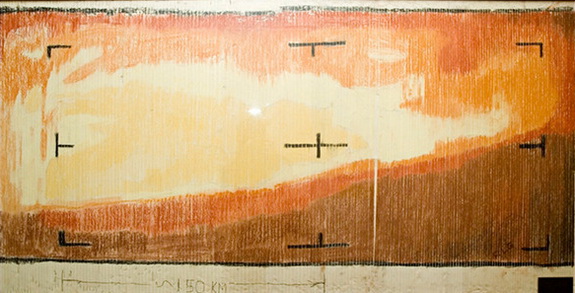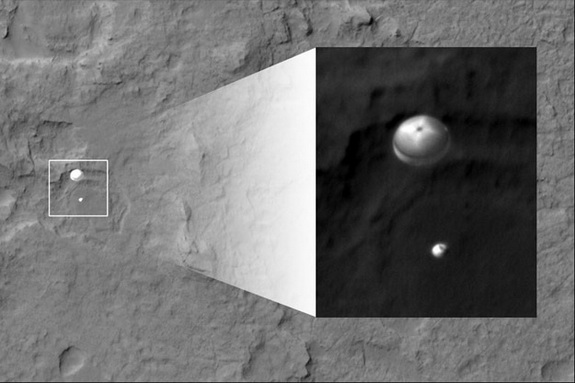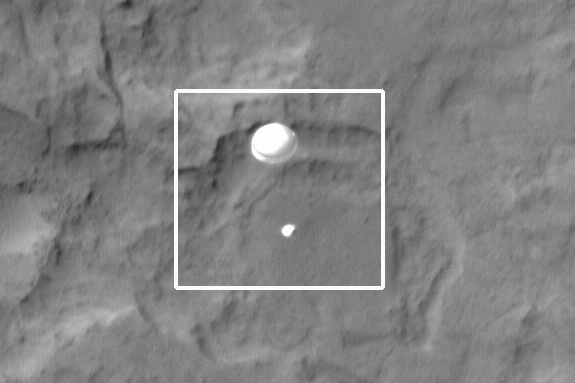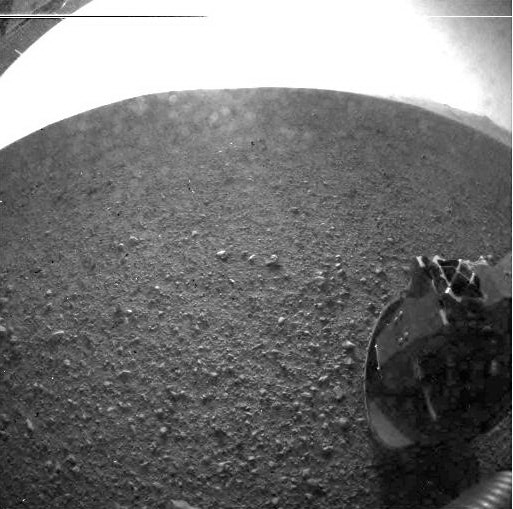My writing time this week was interrupted: I only started in the late evening, because I had my satellite TV tuned in to the Jet Propulsion Laboratory, where they were monitoring the landing of the latest rover on Mars, Curiosity (the best-named science craft ever); the mission itself is called the Mars Science Laboratory — accurate, if not as inspiring.
Landing was a long sequence of near-impossible engineering feats; if one thing went wrong, it was all over.
Risky Business
Mars probes only have about a 40 percent success rate as it is, and this one was particularly complex. It went from 13,000 mph to a soft landing in 7 minutes; the Jet Propulsion Laboratory engineers called it “Seven Minutes of Terror”. If you haven’t seen the explanation of that, this 5-minute video is a must-see:
JPL, which is the NASA center responsible for robotic probes to the planets (and where I worked for 10 years), emphasized that it was quite possible that, due to expected radio blackouts as the spacecraft transitioned from one part of the landing sequence to another, they might not even know whether it landed safely for as long as three days.
Yet everything went beautifully last night: they had a solid data link most of the time, even when the Earth “sunsetted” from the lander’s point of view, as flight controllers had rigged up one of the Mars-orbiting spacecraft to relay its signal (itself quite difficult, since that orbiter wasn’t designed to do that).
They were able to monitor nearly every portion of the descent and successful soft landing right next to a mountain.
First Light
The audacious plan worked perfectly. So much so that they were able to get a picture of the surface within minutes after landing! Why, in my day, we had to print out the actual digits, 0-7 (8 bits!) and color them in with crayons! OK, that was actually before my day (by Mariner 4 in July 1965), but that really is how the first photo from Mars was created so scientists could see the surface as soon as possible.
I’ve seen the original at JPL. Here’s a copy:

And while the Curiosity team was at it, someone at JPL had the bright idea of programming the other Mars orbiter to take a picture of where they expected the parachuting lander to be as it flew over! The High Resolution Imaging Science Experiment, aboard the Mars Reconnaissance Orbiter, got the photo.
“If HiRISE took the image one second before or one second after, we probably would be looking at an empty Martian landscape,” said Sarah Milkovich, JPL’s HiRISE investigation scientist. “When you consider that we have been working on this sequence since March and had to upload commands to the spacecraft about 72 hours prior to the image being taken, you begin to realize how challenging this picture was to obtain.”
And here it is:


Brain Power!
Yep, I had the extreme privilege to work with men and women like that for ten years. It’s what really cemented my appreciation for thinking. Helping others understand the value of thinking, and reminding them to do that (for instance, to consider the repercussions of their actions), has become my life mission. This is True is my vehicle for doing that; it’s entertaining so that people will read it, but entertainment is a function, not the mission.
As for Curiosity’s landing, reader Deborah in Washington, D.C., put it this way: “Events like this are the definition of the word ‘awesome’.” Yes. Yes they are. I’m so proud of my former colleagues at JPL for their awesome accomplishment.

– – –
Bad link? Broken image? Other problem on this page? Use the Help button lower right, and thanks.
This page is an example of my style of “Thought-Provoking Entertainment”. This is True is an email newsletter that uses “weird news” as a vehicle to explore the human condition in an entertaining way. If that sounds good, click here to open a subscribe form.
To really support This is True, you’re invited to sign up for a subscription to the much-expanded “Premium” edition:
Q: Why would I want to pay more than the minimum rate?
A: To support the publication to help it thrive and stay online: this kind of support means less future need for price increases (and smaller increases when they do happen), which enables more people to upgrade. This option was requested by existing Premium subscribers.

Something else you may like.
—
Vern’s message: that Curiosity’s tires have cutouts that leave Morse Code impressions in the Martian sands. It spells out “JPL”. -rc
I was at the Denver Museum of Nature and Science last night (on my birthday) for the presentation they did. They started out by selling seats in the IMAX theater and by the time it was done they were stuffing folks in nooks and crannies and sold 1300 tickets.
It was quite amazing and thrilling to be there when they got the first photos only minutes after landing.
—
Nice to hear there was that much interest! -rc
I remember using spindle cards at JPL when I was a science aide for the Viking Lander Imaging Team (Extended Mission) in 1977. How did we ever manage with that ancient tech!
Reference to the split-second timing needed to capture the still picture of the lander hanging on its parachute reminded me of some other split-second pictures.
A Google image search for “ISS solar transit,” with or without the quotes, will bring up photos of the ISS passing between the camera and the sun. I don’t know the duration of these transits but it’s not much time. I think the shutter is tripped automatically by calculation.
*sigh* Some people are smarter than I am.
73, KD6VKW
—
Yeah, those transits are reasonably easy to get once they’re predicted. -rc
This was a beautiful event. I had tears in my eyes during much of the end of the landing as each new success marker was reported. Congratulations JPL, NASA and, well, us!
As soon as I heard last night was the night for Curiosity’s landing, I switched my TV over to the NASA channel and watched this for hours. It was fascinating to see the faces of the engineers who worked on this project (and I loved the multi-colored mohawk!) I watched them go from calm-excited, as they did their pre-landing system checks, to “I can hardly hold it in!” in the few minutes before landing (the Seven Minutes of Terror). The explosion of emotion and joy when they had confirmation of touchdown: tears, laughter, hugs, etc, was fantastic. Despite the fact that I’m nearing the END of my career, I was wondering what I needed to do to get a job with NASA or JPL so that I could be involved in a project like this. Our moon landings and shuttle journeys might be in the past, but this type of project is definitely a new one for our kids to dream on.
—
“Mohawk Guy” is Bobak Ferdowsi. He was the mission controller, and got quite a bit of notoriety with his red and blue dye job, and white stars on the shaved sides of his head. -rc
I LOVE how it took about three minutes for the first jokester to photoshop in an Alien image.
—
Yes, Marvin the Martian made an appearance quite quickly. -rc
Ok, I know I’m missing the point here, but being a geek, I cannot let the sentence “0-7 (8 bits)” stand without comment. 8 bits would be 0-255. 0-7 only needs 3 bits.
—
I’m ok being corrected, since I don’t know exactly how the transmission was done. If I get something clear (e.g., from a retired JPLer!), I’ll correct the essay. -rc
I am a systems engineer for mission critical embedded systems.
All I can Say is: WELL DONE!!! Ad Astra!!
—
For those who don’t know, “ad astra” is Latin for “To the stars.” It’s commonly heard among space engineers and enthusiasts. -rc
Having grown up witnessing our space program since the Mercury flights, I read any articles in this genre before I read anything else in the news. Always it is breath taking news, whether from the drama of brave lives at stake, or the intricate technical brilliance of the people who dream up and then execute these missions.
Last night I followed Curiosity’s trip to the surface of Mars, literally on the edge of my chair at times, even though I had to get up early this morning. It was another wonderful step in mankind’s inevitable voyage through our universe. Kudos to all who pulled it off. What an excellent time we live in — I think it would actually be curative for the world to focus on things like this, instead of the discord and disharmony which makes up most of the news. No matter what, there are always great things taking place somewhere in the world.
Several weeks ago someone on NPR wondered out loud if some of JPL’s engineers might have died last night for holding thier breath for seven minutes.
@Nicolai: I assumed that 0-7 meant “bits 0 through 7 of each byte”. But yeah, if it was an 8-color palette (quite likely back then), 3 bits would suffice. Maybe the other 5 bits were parity (x2) and a second copy of the 3, for error correction 🙂
—
They do definitely use some heavy-duty error correction schemes, but it would still be cool to hear the details of how they did it back then. -rc
“Mohawk Guy” really brought home the changes we have seen from the Mercury-Gemini-Apollo days of white shirts and skinny ties. Bravo Zulu to JPL.
—
And crew cuts! -rc
Just tiny correction for a comment:
Actually if it is the image I know of then it existed significantly earlier.
Also that thread has quite some interesting things discussed before and after landing.
I still remember quite clearly as a small child standing in the back yard with my parents and aunt and uncle watching the Sputnik traverse the shell of the night sky. The journey to space has held my attention and imagination ever since. Following the flight of Curiosity has pushed the envelope of my ability to be awed and amazed. Much like John, I am brought to tears by the accomplishment of these extraordinary people who have engineered this marvelous Conestoga. Hearing the cheers and watching the victory dance from the control room, I felt I was a part of the journey, simply by wishing and imagining that it would happen and happen successfully. I imagined the spirits of Heinlein and Bradbury cushioning the descent and watching serenely as we chronicle this strange new land. Curiouser and curiouser.
Thanks for the summary. I thought of staying up to watch it, but it was just too late in EDT. When I watched “Seven Minutes of Terror”, I just had to shake my head at the improbability of pulling it off — the parachute, the crane drop — and yet they managed it!
Even deciding to try such a deceleration/landing was pretty ballsy, but getting it right (e.g. dodging the parachute), and making it work, is pretty spectacular.
This is the kind of story that shows the other side of the bell curve from most of your newsletter. The kind with brilliant people working hard to increase humanity’s knowledge.
Hearing that JPL had put their initials in morse code on the treads showed that as we go out into the universe, we send the best of ourselves, including a little bit of whimsy.
It reminded me that the circuit boards of Spirit and Opportunity have Marvin the Martian on them. We all know how widly successful Spirit was and Opportunity still is. Here’s hoping that Curiosity’s future is that bright.
Working with a thermodynamics engineer at McDonnell Aircraft, I wrote the computer program to calculate the heat flow on the ballistic heat shields used on the Mercury, Gemini, and Apollo capsules. There were so many calculations involved that it took one hour to run on an IBM 9094, the fastest computer at the time. The result was a single number that was directly convertible to required shield thickness. Engineering had estimated that 4 inches was necessary. After multiple runs at various angles of attack, we determined that 1 inch was sufficient. Management settled on 2 inches.
Sadly, I had to work that night, so I didn’t get to see the landing itself. I’m glad it worked.
The cable “news” made me angry that night, though — they kept calling the landing a “miracle”. I mean, sure it was difficult and had a significant chance of failure, but it was all about the engineering and the work of man, nothing divine about it. And then I had to explain to a coworker (who was alive for Sputnik, even if I wasn’t) that this wasn’t the first probe to land successfully on Mars. Disturbing, I know.
Oh, and if the picture really was 8 bits…well, 256 colors was the standard for years, so I don’t find that terribly hard to imagine either.
—
It was “amazing,” it was “awesome,” it was a “brilliant feat” and more. It was definitely not a “miracle.” What a stupid comment by that news droid. -rc
@Bob, On one hand, there is always the possibility of errors in the calculation or undetected flaws in the heat shield. On the other, the people signing the checks always try to cover their hineys.
@Brian, Yes, there are lots of people who don’t see the value in exploration. My parents are two of them. My father was going on and on about throwing away billions of dollars. He stopped when I mentioned that all of those billions were spent here on earth. That’s a lot of jobs for a lot of people. Hundreds of jobs directly, and thousands of jobs when you look at the impact of this one project.
—
And not just jobs: the spinoffs that improve our daily lives are innumerable, and have created industries. -rc
The comment about the crowd in the Denver museum made me want to report that the local Air and Space Museum (doubles as the NASA Langley Visitor Center) sold out their 300 seats in the IMAX for the 1:37 AM landing. There is interest here also!
Bravo to all the JPL and NASA folks that worked so hard to get Curiosity built, launched and down safely. Onward to the exploration!
Even Mr. Spock tweeted about the landing:
@TheRealNemoy: I have Vulcan cousins on Mars. They are gracious hosts. Welcome NASA. LLAP
—
Fun! -rc
This doesn’t quite answer your question about the Mariner 4 image, but thought you might find it interesting anyway.
The original hand-coloured image was displayed in an art museum exhibit, Data+Art, here in Pasadena, CA. Although I work on Mars rover missions (including Curiosity) and see all of the beautiful photos of Mars they return, seeing that first picture — hand-coloured by the excited engineers just to make sure their instrument actually worked — took my breath away. Those pioneers — and their fellows on Viking and Voyager — are why I work on Mars rovers today.
—
Dick Grumm was legend at JPL when I was there; I hope he still is. Thanks for the link to the more complete story! I loved showing the “crayon” image to visitors. -rc
Brightened colour Mars photo from Curiousity.
http://www.nasa.gov/images/content/676031main_pia16051-figure_2_brightened-portalfull.jpg
—
It’s a great composite photo, but WARNING: it’s 10.4 MB. -rc
I’m a devoted reader of Risks Digest, which discusses what happens when your latest fool-proof system meets Mother Nature’s latest, greatest and massively upgraded, fool.
The mantra there is that no mission critical system should ever ever ever have a “single point of failure.”
The Curiosity landing had so many single points of failure on the re-entry side that I was pretty dang worried about it.
If you can winkle some tales out of your JPL buddies on how they dealt with that, I think your readers would love to see it. Well I would at least.
—
I unfortunately don’t know too many people at JPL anymore — most of them have retired or otherwise moved on. After all, I left in 1996! Time flies. -rc